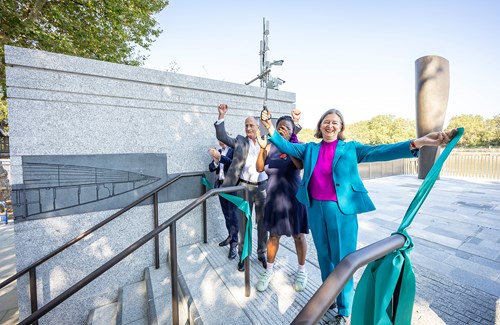Opening of new riverside space at Putney Embankment marks step forward for London’s super sewer


- Putney Embankment Foreshore – the first of a new network of riverside public spaces – opens as part of Thames Tideway Tunnel construction
- Locally inspired artworks, including a new cast-bronze marker for the start of the University Boat Race, unveiled for the first-time
- New tunnel will cut Thames sewage pollution by 95 per cent – due for activation in 2024
A brand-new piece of public space built out into the Thames as part of the super sewer project has been officially opened, in Putney.
The opening of the riverside space in an area synonymous with the river community, makes visible for the first time the above ground legacy of the super sewer, with hints to the feat of engineering deep below.
The new sewer tunnel is due to be activated in 2024 when sewage overflows will be diverted away from the river for the first time. When fully operational in 2025, the tunnel will prevent an estimated 95 per cent of sewage spills from entering the river.
The 500m2 space just west of Putney Bridge is the first of seven new mini parks to be created as part of the project, all with unique architectural features and specially commissioned artworks.
Putney Embankment Foreshore was opened on Friday 15 September, providing a space for people to pause and enjoy the river.
Timber-laid benches facing the river are positioned to make the most of the panoramic view upstream towards Hammersmith and downstream, through the bridge arches. The Cornish granite comes from the same quarry used to construct Putney Bridge, nearly 140 years ago.
Clare Donnelly, Tideway’s Lead Architect, said: “This is a fantastic moment for the Tideway project as we open the first of seven new pieces of public space along the Thames. Our vision for creating the spaces has been to reflect the local area and its heritage and we hope that people will explore this new part of Putney.”
Glasgow-based artist Claire Barclay has created Water Finds a Level which is a series of three artworks that respond to the area’s heritage of commercial and recreational boat use.
Visitors will discover a range of features including bronze oars forming the handrails of the balustrade and a relief sandblasted into the granite walls of the operational kiosk building. The University Boat Race is celebrated with a strip of bronze inlaid into the granite paving to mark the start line.
Other design elements include a sculptural bronze ventilation column and subtle uplighting.
The site will be handed over to Thames Water in 2025 when the super sewer is fully operational.
Nevil Muncaster, Strategic Resources Director, Thames Water, said: “I am delighted that we have reached another great milestone with the opening up of this public space along the river in Putney for everyone to enjoy. We remain focused on working with our partners to complete this project on schedule. We are looking forward with excitement to bringing the tunnel into service – so that it can do the vital job of improving the health of the River Thames and London’s environment."
NOTES:
Tideway
Tideway is the company delivering London’s new super sewer.
Tideway’s work at Putney involved ‘intercepting’ the Putney Bridge combined sewer overflow (CSO), which spilled an average of 68,000 tonnes of untreated sewage into the Thames each year.
The CSO has been diverted away from the Thames via new culverts and shafts and into the super sewer, which runs deep beneath the river carrying flows eastward toward Europe’s largest treatment works in Beckton.
Thames Water
Thames Water is the UK’s biggest water and wastewater services provider. The company’s key workers provide essential services around the clock to 15 million customers across London, the Thames Valley, and surrounding areas.
Thames Water currently treats 4.6 billion litres of sewage at over 350 sewage treatment works on a daily basis and maintains over 68,000 miles of sewers across its network.
Artwork
Water Finds a Level is part of Art on the Tideway, a series of over 50 temporary and permanent artworks commissioned by Tideway that respond to the local heritage and history of the sites in which they are located.
Water Finds a Level has three elements. Three bronze oars, cast from different types of heritage oars – used on a barge, a wherry, and a skiff – have been set as handrails in the river-facing balustrade. Ranging in length and character, they subtly reflect the role the river played in transporting everyday goods and passengers. Details of the wear and tear of these historical oars have been replicated by the casting process, creating a narrative texture, which the artist invites people to explore.
The University Boat Race start line is celebrated 'celebrated with a text within the bronze inlaid which reads: ‘The Best Leveller is the River we have in Common’ and ‘The Tide and the Wind Direct our Paths’, which is inspired by footage of a Thames Lighterman describing his superiors as the ‘wind and the tide’. The typeface, Doves Type, has its own intriguing history – created in 1899 for a Hammersmith printing press it was subsequently thrown into the river following a feud between the owners. Over a century later, typographer Robert Green salvaged some of the type to recreate a digital facsimile that has enabled use of the type across a number of the new areas of riverside space created by the super sewer.
The final artwork is a graphic relief sandblasted into the granite walls of the mechanical and electrical building that is needed to operate the sewer. Based on archival plans and illustrations found at the National Maritime Museum, it depicts a Thames skiff boat – a traditional small wooden rowing boat developed in the 19th century for leisure.
Read more about Putney here.









